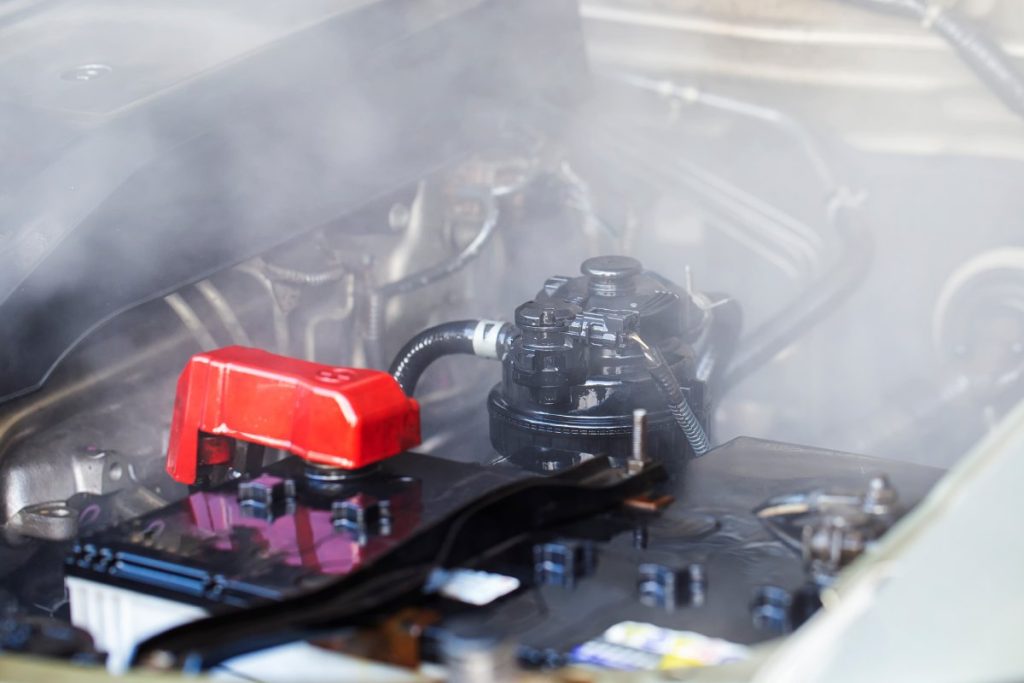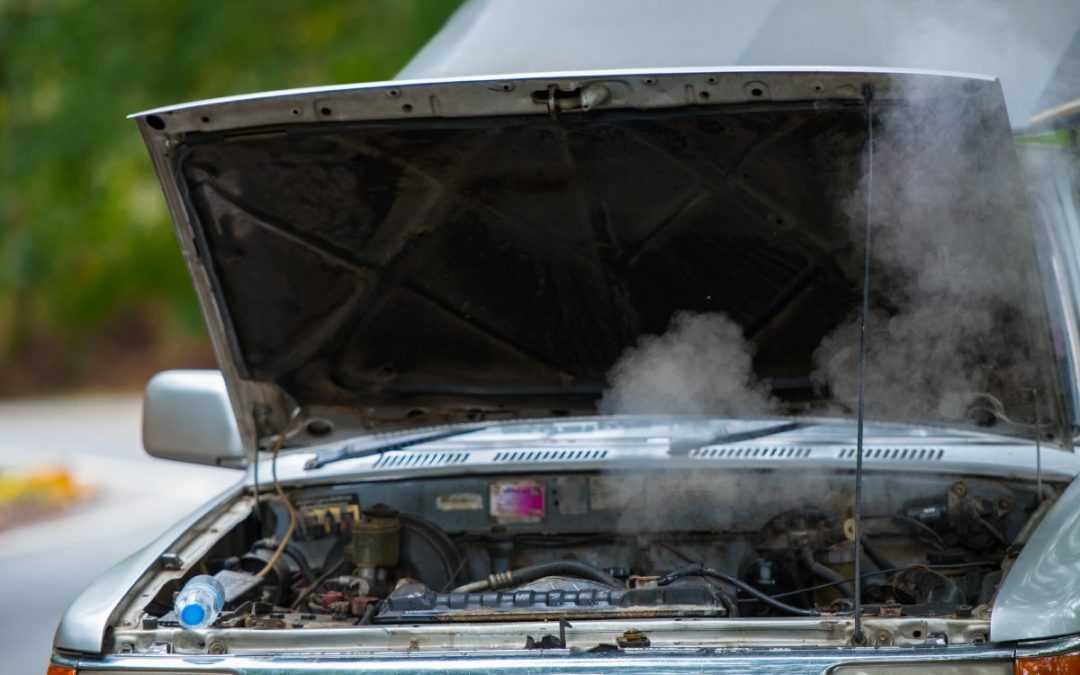Home » Stop the Steam: How to Keep Your Car from Overheating
- How to Keep Your Car from Overheating with Regular Maintenance
- How to Keep Your Car from Overheating During Hot Weather
- How to Stop a Car from Overheating on the Road
- How to Keep Your Car from Overheating Year-Round
- Stay Cool: Protect Your Engine and Drive with Confidence
- Cooling System Repair in Fargo-Moorhead
- Frequently Asked Questions
- Fargo Car Overheating Repair
- Moorhead Car Overheating Repair

Few things are as stressful as seeing that temperature gauge shoot up or, worse, seeing steam pour out from under the hood. When your car overheats, it’s not just an inconvenience—it’s a serious threat to your engine that can lead to costly damage. Understanding the causes and, more importantly, the solutions is key to keeping your ride running smoothly and your wallet safe.
At Matt’s Automotive Service Center, a family-owned and operated business with a commitment to excellence in the Fargo-Moorhead and Minneapolis-St. Paul, we believe in helping you prevent problems before they start. Our goal is to set a new benchmark in the industry by being much more than a typical auto repair shop. We want to be your trusted resource.
How to Keep Your Car from Overheating with Regular Maintenance
The best defense against an overheating engine is a great offense—regular maintenance. Your car’s cooling system is a complex network of parts, and neglecting just one can cause the whole system to fail. If you’re asking, “Why is my car overheating?” the answer often comes down to one of these areas:
The Cooling System: Your Engine’s Best Friend
The cooling system’s job is simple: remove excess heat from the engine. It circulates a mixture of water and antifreeze (coolant) through the engine block to absorb heat, then moves it to the radiator to cool down, and then back again. When this cycle is broken, you have a problem.
Cooling System Repair and routine checks are non-negotiable for long-term engine health. Here are the core components you need to keep an eye on:
- Coolant (Antifreeze) Check: Coolant is the lifeblood of the system. Check its level regularly—when the engine is cool! Low coolant is one of the quickest causes of an engine getting too hot. This is a simple yet vital step in engine cooling system maintenance.
- Hoses and Belts: Over time, the rubber hoses can become brittle, cracked, or soft, leading to leaks. A broken belt (like the serpentine belt) can stop the water pump from working, which means no coolant circulation. Have a skilled and dedicated auto mechanic inspect these during every oil change.
- The Radiator Cap: This small, often overlooked part maintains the pressure in the system. If the cap is faulty, the coolant can boil at a lower temperature, leading to overheating. A quick check of the seal can prevent a major headache.
- The Thermostat: The thermostat controls the flow of coolant. If it gets stuck closed, coolant can’t circulate to the radiator, and your engine will overheat quickly. This often requires professional cooling system repair.
Radiator Maintenance: The Heat Dissipator
The radiator is the star of the show when it comes to cooling. It uses air flow to remove heat from the coolant. If the radiator is clogged, dirty, or leaking, it can’t do its job.
Follow these essential radiator maintenance tips:
- Flush the System: Over time, sediment and corrosion can build up inside the radiator and the engine’s coolant passages. A professional cooling system flush removes these contaminants and replaces the old, tired coolant with fresh fluid. We recommend doing this according to your car manufacturer’s schedule.
- Keep it Clean: The outside of the radiator can get blocked by bugs, dirt, and road debris, especially during summer driving. Less airflow means less cooling. A quick, gentle spray can clear away the grime.
- Check for Leaks: Visible leaks (puddles of sweet-smelling fluid) or rust spots on the radiator are clear signs you need immediate attention from specialized car technicians.
How to Keep Your Car from Overheating During Hot Weather
Summer heat is brutal on a car’s cooling system. The hotter the air temperature, the harder your car has to work to shed heat. Learning how to prevent car overheating in summer is crucial, especially in the sweltering heat of North Dakota and Minnesota.
- Don’t Overwork Your A/C: Your air conditioning system puts extra strain on the engine. If you are idling in traffic or driving up a long, steep hill on a scorching day, turn off the A/C or switch to just the fan for a bit. Reducing this load can give your engine a much-needed break.
- Mind the Traffic: Stop-and-go traffic is a killer for cooling systems. When you’re not moving, there is no air flowing over the radiator to cool the coolant. If possible, try to drive during less congested hours.
- Keep Your Coolant Mix Right: You need the correct ratio of water and antifreeze. Too much water lowers the boiling point, and too much antifreeze lowers the cooling efficiency. Always use the specific type of coolant recommended by your car’s manufacturer.
How to Stop a Car from Overheating on the Road
Sometimes, despite your best efforts, you might experience the signs of engine overheating. The temperature gauge starts to climb, the ‘check engine’ light flashes, or you hear a strange bubbling sound. Don’t panic! Knowing what to do when your car overheats can prevent catastrophic engine damage.
- Turn Off the A/C and Turn on the Heater: Yes, you read that right. Turning on the interior heater and fan to the maximum setting draws hot air away from the engine block and into the cabin, acting as a secondary cooling system. It might be uncomfortable, but it’s a temporary fix that can save your engine.
- Pull Over Safely: As soon as possible, pull over and turn off the engine. Do not try to keep driving. Find a safe spot, put the car in park, and shut it down immediately.
- Wait and Inspect: Let the car cool down for at least 30 minutes. NEVER open the radiator cap or coolant reservoir cap when the engine is hot. The pressurized, boiling-hot fluid will spray out and cause severe burns. Once cooled, you can check the coolant level. If it’s low, add a 50/50 coolant mix or, in a pinch, water, to get to a local mechanic.
- Call for Help: If you’ve added fluid and the temperature gauge climbs right back up, the issue is beyond a quick fix, and you need a tow. The moment you see that needle in the red, it’s time to call the professionals at a trusted mechanics shop like Matt’s Automotive Service Center.
How to Keep Your Car from Overheating Year-Round
While summer is the most obvious time for overheating, cold weather can also reveal underlying issues. A healthy cooling system is essential 365 days a year.
Addressing overheating car causes and solutions should be part of your yearly car care checklist:
- Check for Leaks: Small leaks are the number one cause of low coolant. They might be hard to spot, but can be coming from the radiator, hoses, water pump, or a faulty gasket. Catching a leak early is much cheaper than replacing a head gasket later.
- The Water Pump: This component is what keeps the coolant circulating. If you hear a whining noise coming from the front of the engine, it could be a sign of a failing water pump. This requires immediate auto repair cooling system service.
- The Fan: Your car has an electric fan or a fan clutch that kicks in to pull air across the radiator when the car is idling or moving slowly. If this fan isn’t working, your car will overheat in traffic. You can often see and hear the fan working when the engine is hot and the A/C is running.
By focusing on these points, you take an active role in keeping your car from overheating, protecting your investment no matter the season.
Stay Cool: Protect Your Engine and Drive with Confidence
Engine overheating is not a problem that fixes itself. Ignoring a climbing temperature gauge is the single most destructive thing you can do to your vehicle. It can lead to warped cylinder heads, blown head gaskets, and total engine failure—the cost of which is almost always in the thousands of dollars. Prevention is absolutely the most affordable solution.
We understand that taking care of your car can sometimes feel overwhelming. That’s why our growing team of skilled and dedicated auto mechanics at Matt’s Automotive Service Center is here to help.
With 10 locations across Minnesota and North Dakota, including Fargo-Moorhead and Minneapolis-St. Paul, we are committed to earning and maintaining your unwavering trust. Our goal is to provide specialized car technicians who don’t just fix cars, but provide an auto repair experience that sets a new standard for excellence.
Cooling System Repair in Fargo-Moorhead
Don’t wait for the steam to start rising. If you’ve noticed your temperature gauge creeping up, it’s time for an inspection. Whether you need a simple coolant flush, radiator maintenance, or complex cooling system repair, the experts at Matt’s Automotive Service Center are ready to assist.
Stop stressing about whether or not your car can handle the daily drive or a long road trip. Schedule your comprehensive engine cooling system maintenance service today!
Contact us at 701-478-3838, reach our Facebook page, or visit one of our 10 convenient locations in the Fargo-Moorhead or Minneapolis-St. Paul, area to book an appointment with our trusted mechanics at Matt’s Automotive Service Center and ensure your engine stays cool, calm, and collected all year long!
Frequently Asked Questions
Why is my car overheating even with enough coolant?
Even with sufficient coolant, your car can overheat due to a faulty thermostat, broken radiator fan, clogged radiator, or failing water pump. Routine cooling system inspections can help identify and fix these problems early
How often should I flush my radiator?
You should flush your radiator every 30,000 miles or as recommended by your car manufacturer. Regular radiator flushes prevent sediment buildup and corrosion that can lead to engine overheating.
What should I do if my car starts to overheat on the road?
Turn off the air conditioning, switch on the heater, and pull over safely. Let the engine cool for at least 30 minutes before checking the coolant level. If the problem continues, contact a professional mechanic for cooling system repair.
How can I prevent my car from overheating in hot weather?
To avoid overheating in summer, maintain proper coolant levels, avoid heavy A/C use in traffic, and ensure your radiator and fan are clean and functional. Regular maintenance checks are key during high-temperature months.
Can a bad radiator cap cause overheating?
Yes. A damaged or loose radiator cap can lower system pressure, causing coolant to boil and the engine to overheat. Checking and replacing a faulty cap is a simple but essential step in cooling system maintenance.
What are common signs of cooling system failure?
Common warning signs include a rising temperature gauge, coolant leaks, steam from the hood, a sweet smell, or unusual engine noises. Address these symptoms immediately to prevent major engine damage.


Recent Comments